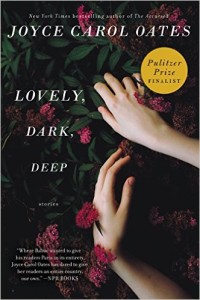
Diana Berman, Director
Edited by: Marly Swick
Composed by: Diana Berman, Iman Bluhm, Tally Chilvers, Judith Jenya, Beverly Spiro, Marly Swick
Lovely, Dark, Deep is a collection of short stories. Short stories are created differently than a novel. Although short stories take many forms and writers experiment endlessly, there is a classic short story structure that is taught in any beginning fiction writing workshop. You will notice this structure operating to varying degrees in this collection. In the classic form there is some sort of inciting incident that gets things moving. Then there is the RISING ACTION as the plot builds to the CRISIS OR TURNING POINT, followed by the much shorter FALLING ACTION which leads to the RESOLUTION.

In the modern short story the resolution is generally more implied or suggested than spelled out. For example, “The Mastiff,” which received a prestigious O’Henry Prize, follows this classic plot structure. It takes place around a single incident, the time span is just a few hours, the plot follows the classic arc: rising action, climax or turning point, resolution.
The five stories from Lovely, Dark, Deep we will focus on are: “Sex with a Camel,” “The Mastiff,” “The Hunter,” “The Disappearing,” “The Jesters.”
Questions:
- “Sex with a Camel” is a story with the most positive relationship in this collection. There’s a suggestion that there is something different about a relationship between a grandchild and grandparent and something special that these two characters share. How would you describe it? How did they both nurture the connection between them? What do you think of the symbolic meaning of the grandmother driving to the hospital and the grandson driving home?
- Hemingway famously believed that a short story was “the tip of the iceberg” i.e. much of the short story should remain under the surface for the reader to grasp. In “Sex with a Camel,” the story focuses on the boy taking his grandmother, who has cancer, to the hospital for treatment. At one point the boy thinks that he is “sick of his own sad story.” Do you think that there is more to his sad story than what we are reading about here?
- “The Mastiff” is a suspenseful story with a high level of fear deliberately created. Joyce Carol Oates wrote, of “The Mastiff,” “If you are not afraid of much in life, you haven’t experienced life yet! There is much, much to be fearful of, though perhaps it is not a good idea to know this. The disasters that you might expect are not likely to happen, but others will, totally unexpected ones. Out of nowhere, they will come, and you will say, ‘but I had no idea’. That is the point: you have no idea. Just wait?” How does this attitude toward fear and the unknown resonate or not with you?
- In “The Mastiff” the author made a conscious decision to refer to the two characters as “the woman” and “the man” though their names come up at some point. What do you think was the reason for that? Are they intended to be types or specific people? Did it engage you or distance you from the characters?
- In “The Mastiff” the main character, Mariella, is a single (never been married) woman about to turn 41, while in “The Hunter” the main character, Violet, is also a single (never been married) woman about to turn 40. One owns an art gallery and the other is a successful poet. Reading these two stories together, what do you think about how JCO presents these independent woman?
- “The Hunter” has several threads running through it as opposed to, say, “The Mastiff.” Oates brings in the underground railroad, an affair with a single middle aged poet and the President of a small college, the looming death of the woman’s father and an italicized incident of a homeless man biting her lip – a visible vulnerability. Why do you think Oates brought all these threads into the story? Do you think that she resolved them? How did this affect your sense of the story?
- The opening couple of pages of “The Hunter” are a brilliant description of the setting-the college president’s historic mansion. How does this description of the setting skillfully lay the groundwork for the climax of the plot and the themes of the story?
- The majority of short stories use the technique of flashback to inform the reader about what’s happened in the past of the story. In “The Disappearing” there is a nine page flashback to an incident that took place when the couple was young and newly married and they came home to find their house burglarized and they called the police. This is a lot of pages to devote to a flashback in a short story, so how is what we see in that flashback so crucial to this whole story? Do you feel it represented a turning point in their marriage?
- “The Jesters” is a surreal account of a pivotal summer in the lives of an aging suburban couple where life seems to be falling apart as they knew it. Confronted by a mysterious, evolving yet questionable presence, the “Jesters” become a foil for their lives as well as an active player in it.
How did these “Jesters” bring into focus the character of the couple’s life together and the direction it is taking? - What do you make of the bizarre turn the story takes when the couple in “The Jesters” actually drive to the neighbors’ house to find it an abandoned wreck where an arson involving fatalities occurred some years back? Does this shift the story from what seemed like realism into a Ghost Story in this climatic scene?
- Both “The Dissappearing” and “The Jesters” are about empty nesters—two upper middle class couples who seem to be falling apart emotionally. The wife in “The Jesters” thinks: “She no longer made inquiries. Much of his life was separate from hers as if each was on an ice flow, drifting in the same direction yet drifting inevitably apart.” In “The Disappearing,” the wife thinks: “In marriage the most intense conversations were often with oneself.” What view of the empty nester marriage do you get from these two stories? How relevant does it seem that both couples seem to be from the same socio-economic class.
- As long-time editor of the Oxford Book of American Short Stories which spans over two centuries—from “Rip Van Winkle” to the present—Oates suggests in her overview that “the most profound change in the American short story may be the movement from the mythic to the anecdotal, from a mode of impersonal storytelling … to a mode of storytelling that is intensely personal, self-conscious, and narrated by a distinctive “voice.” So where do you see elements of the mythic or supernatural in Lovely, Dark, Deep?
